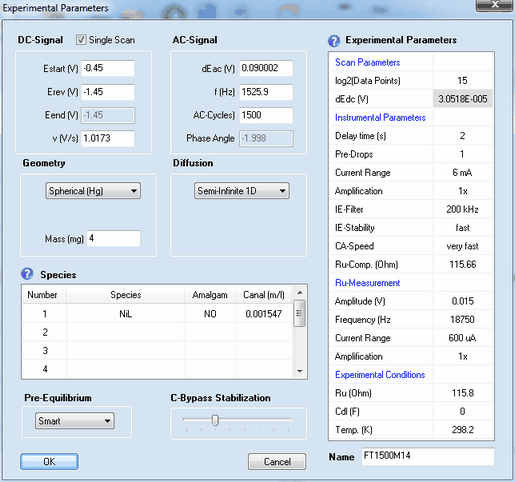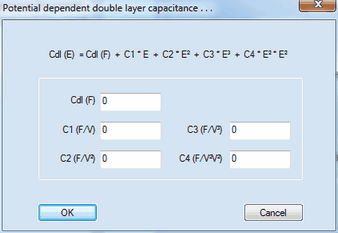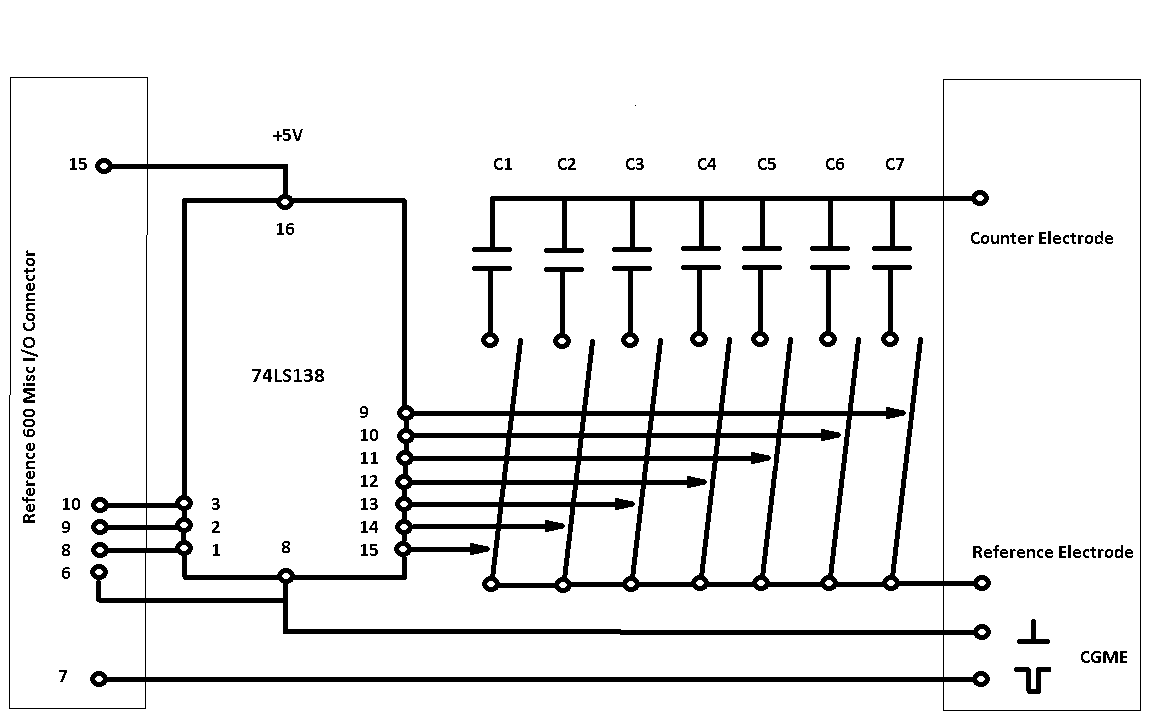Menu Command: Edit |

|

|
|
Menu Command: Edit |

|

|
This command opens a dialog box that enables the user to specify the following parameters referring to the active experiment:

![]() A value of Cdl (F) written in magenta indicates that a time/potential dependent double layer capacity has been entered by the user. The polynomial coefficients describing the dependence of the double layer capacity as function of the electrode potential can be edited by clicking with the right mouse button while the cursor is localized over the input field associated with Cdl (F).
A value of Cdl (F) written in magenta indicates that a time/potential dependent double layer capacity has been entered by the user. The polynomial coefficients describing the dependence of the double layer capacity as function of the electrode potential can be edited by clicking with the right mouse button while the cursor is localized over the input field associated with Cdl (F).
•Check Box: Single Scan
This check box is activated if only the forward scan of the DC-signal is to be executed. Eend (V) is automatically set equal to Erev(V) and the input field for Eend (V) will be blocked.
•Estart (V), Erev, Eend (V), v(s)
The DC-scan can be composed of up to 2 scan segments characterized by starting potential, Estart (V), end-potential, Eend (V), and scan rate, v (V/s).
•log2(Data Points)
The number of data points used for generating the signal. It must be an integer power of 2 and is 2^14 = 16384 by default.
•dEdc (V)
The potential difference between subsequent data points (fitting the selected number of Data Points) is shown in the (read only) parameter dEdc(V).
•dEac (V), f(Hz), Phase Angle
The superimposed AC-signal is characterized by Amplitude, dEac (V), frequency, f(Hz), and Phase Angle. The frequency is adjusted such as to ensure an integer value for the number of AC-Cycles. The AC signal is generated by the signal processor of the Reference 600 potentiostat. Unfortunately, the Reference 600 does not allow to control the Phase Angle of the generated AC signal. For this reason, the actually used value of the phase angle is determined by Fourier-Transformation an displayed in the associated read-only field.
•AC-Cycles
The integer number of AC-Cycles which is superimposed to the DC-signal.
•Disabled , Enabled, Smart
When using the experimental CV in a Data Fitting Project the simulation(s) will be forced to be executed for the selected Pre-Equilibrium option.
•Semi-Infinite 1D, Finite 1D, Semi-Infinite 2D
When using the experimental CV in a Data Fitting Project the simulation(s) will be forced to be executed for the selected modus of Diffusion.
When using the experimental CV in a Data Fitting Project the simulation(s) will be forced to be executed for the selected Geometry.
•Delay time (s)
The time elapsing before starting the experiment. When working with an automated mercury drop electrode a delay time of a few second is required to minimize the convection effected by the growth of the mercury drop.
•Pre-Drops
When working with an automated mercury drop electrode n+1 mercury drops are produced (where n is the number of Pre-Drops) but the experiment is executed only at the last drop. Helps to improve the reproducibility of the produced mercury drops.
•Current Range
The Current Range of the Reference 600 potentiostat used in the experiment. (see Reference 600 manual for more details)
•Amplification
The factor with which the originally measured current signal is amplified by the Reference 600 hardware. (see Reference 600 manual for more details)
•IE-Filter
Setting of the hardware filter applied to the originally measured current signal. (see Reference 600 manual for more details)
•IE-Stability
The stability setting (applied to the current-to-voltage-converter) of the Reference 600 potentiostat (see Reference 600 manual for more details)
•CA-Speed
The speed setting of the control-amplifier in the Reference 600 potentiostat (see Reference 600 manual for more details)
•Ru-Compensation (Ohm)
Value of the ohmic resistance that will be compensated for by positive feedback (from the output of the current-to-voltage-converter to the input of the control-amplifier).
•Amplitude (V)
Amplitude of the AC-Signal used for measuring the uncompensated ohmic resistance, Ru (Ohm), and the double layer capacity, Cdl (F).
•Frequency (Hz)
Frequency of the AC-Signal used for measuring the uncompensated ohmic resistance, Ru (Ohm), and the double layer capacity, Cdl (F).
•Current Range
The Current Range of the Reference 600 potentiostat with which the measurement of the uncompensated ohmic resistance, Ru (Ohm), and the double layer capacity, Cdl (F) is started. Will be automatically optimized.
•Amplification
The post amplification factor used for measuring the uncompensated ohmic resistance, Ru (Ohm), and the double layer capacity, Cdl (F).
•Ru (Ohm)
Uncompensated ohmic resistance which has been measured or entered. When using the experimental CV in a Data Fitting Project the simulation(s) will be forced to be executed for an uncompensated ohmic resistance equal to Ru (Ohm) - Ru-Compensation (Ohm).
•Cdl (F)
The double layer capacity which has been measured or entered. If the dependence of Cdl (F) on the electrode potential is already known when doing the experiment and expressible in polynomial form it can be entered by clicking with the right mouse button while the cursor is localized over the input field of Cdl (F) :

Cdl (F) is the constant value of the double layer capacity left over in the limiting case where the dependence of the double layer capacity on the electrode potential expressed by C1, C2, C3 and C4 remains negligibly small. After closing this dialog box only the value of Cdl (F) is displayed in the list of Experimental Conditions but the value of Cdl (F) is written in magenta if one of the coefficients C1, C2, C3, C4 is different from zero. When using the experimental CV in a Data Fitting Project the simulation(s) will be forced to be executed for these values.
•Temp (K)
When using the experimental CV in a Data Fitting Project the simulation(s) will be forced to be executed for this temperature.
![]() The values entered for Ru (Ohm) and Cdl (F) will be overwritten each time when executing the Command: Measure IR-Drop & Run or IR-Drop..
The values entered for Ru (Ohm) and Cdl (F) will be overwritten each time when executing the Command: Measure IR-Drop & Run or IR-Drop..
Click on the first empty input field headlined Species to add a name for each species for which the analytical concentration is explicitly known when running the experiment(s). When using the experimental CV in a Data Fitting Project the simulation(s) will be forced to use the entered analytical concentration provided a species with exactly the same name is found in the mechanism of the Data Fitting Project.
The stabilization level adjusted at this slider bar takes effect only if the reference and counter electrode of the Reference 600 potentiostat are connected by a switchable capacitor shown as shown in the following picture

The following capacitors can be recommended:
•C1 ≈ 0.1 nF
•C2 ≈ 0.22 nF
•C3 ≈ 0.44 nF
•C4 ≈ 1 nF
•C5 ≈ 2.2 nF
•C6 ≈ 4.7nF
•C7 ≈ 10 nF
The optimal value is found by "trial and error". It enables the user to conduct fully IR-compensated CV experiments using scan rates higher than 100 V/s in combination with the CA-Speed level "very fast".
Line 7 of the Reference 600 Misc I/O Connector can be used to trigger the generation of a mercury drop, for instance, by means of the Controlled Growth Mercury Electrode (BASi).